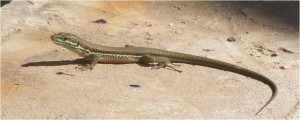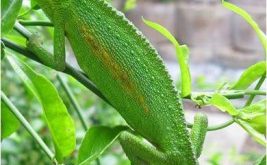Scientific name: Phoenicolacerta troodica
Description
Medium-sized lizard with a relatively large head and dark lines on the side. Total length up to 22 cm with males slightly larger than females. Its tail is 2 – 2.3 cm in size. Its colours are gray – brown with green – brown with black spots along the back. It also has a cream-colored stripe that starts at the snout and reaches to the bottom. These stripes continue along the top of the tail and then disappear. The remaining 2/3 of the tail has a uniform brown colour. Blue marks are especially noticeable during the mating season.
Spreading
This species is found throughout the island from sea level up to 1,500 m.
Ecology
The Troodos lizard lives in gardens, fields, orchards, rocky and wooded areas as well as near settlements. Prefers shady and cool places. At higher altitudes the preferred habitat is the forest, clearings and slopes that have significant vegetation cover, while at lower altitudes the springs, landfills, debris and sometimes well-rooted dunes near the shore. The lizard feeds on insects, especially moths, butterflies and spiders, but also eats fruits and salads.
Behavior
They climb walls and branches of trees where they hunt. They tend to live in pairs in arid areas while in wet areas they are grouped. During the summer, these lizards tend to stay hidden in order to avoid direct sun exposure. Due to their preference for shady habitats, they prefer lowland areas during the summer months and are active early in the morning or evening.
Source:
The Amphibians and Reptiles of Cyprus, Felix Baier, David J. Sparrow, Hans – Jorg Wiedl, 2009.

 Κυπριακό Κέντρο Περιβαλλοντικής Έρευνας & Εκπαίδευσης – Κυκπεε
Κυπριακό Κέντρο Περιβαλλοντικής Έρευνας & Εκπαίδευσης – Κυκπεε




